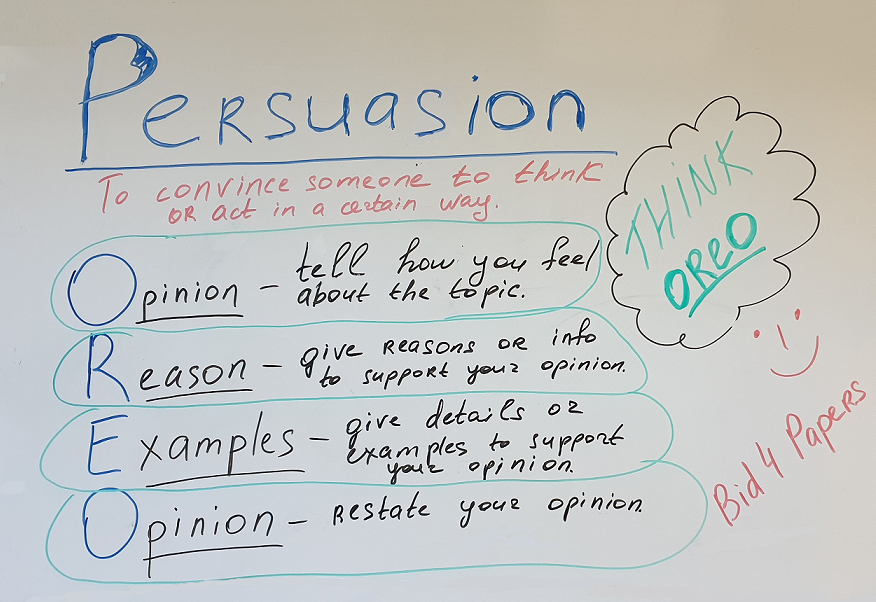|
How to Write a Persuasive Essay by Jesse Seldess, Professional Writer and Mr. E. James, B.A., M.Div.
When writing a persuasive essay, your purpose is to convince your audience to embrace your idea or point of view. Keeping this purpose in mind is the key to writing an effective persuasion. |
|
Essential steps for writing a persuasive essay:
How to organize your persuasive essay:
Introduction
Body paragraphs
Opposing view
Conclusion
PERSUASIVE ESSAY ASSIGNMENT
DIRECTIONS: Follow the directions below and write a persuasive essay. The essay will be due by the end of the hour on THURSDAY. You may turn in the essay earlier if you wish.
Persuasive Writing Assignment
Write a FIVE or more pararaph persuasive writing using the guide that you have been given. Your topic will be that Keota High School should allow students to miss up to 18 days a semester without failing. Make sure that you have a minimum of grammatical mistakes. The writing is due on Thursday…no later! It is worth 200 points and equals a test grade. Your audience that you are trying to persuade will be Mrs. Morris, Mr. Akins, and the board of education.
REMEMBER YOU WILL DO A BETTER JOB IF YOU USE FACTS INSTEAD OF OPINION, but if you do use OPINION make sure that the opinion is logical. HAVE AT LEAST TWO OR MORE FACTS TO BACK UP YOUR POSITON. (Get your facts from the internet or from asking students and teachers/administrators what they think.)
REMEMBER, YOUR GOAL IS TO PERSUADE USING RATIONAL THOUGHT. IF YOU USE ANYTHING THAT YOU FIND ON THE INTERNET YOU MUST CITE THE SOURCE (You must tell me where you got it from.) If you do not tell me where you got the material from you have used that MATERIAL WITHOUT PERMISSION--THAT EQUALS to taking something at is not yours. The RESULT WILL BE A FAILING GRADE.
Things that will lower your grade: (THE GRADING RUBRICS THAT I WILL USE)
Less than FIVE paragraphs in length will reduce your grade by one letter.
Too many grammatical errors will reduce your grade by one letter. This also indicates that you did not PROOFREAD your work.
Poor penmanship—if I can’t read it, I can’t grade it!!!!
Obvious lack of planning, If you do not have a plan page, I will not grade your paper.
No logic. IF your paper doesn't make sense, then it can not persuade.
Not geared to the audience for which you are writing.
Use good word choice---use higher level words. I expect you to use words that a high school student should know.
STUDENT SAMPLE: Internet Plagiarism
Not all thieves lurk in dark alleys and parks. Some sit with their faces lit by the glow of their computer monitors, copying, pasting, and printing. It may seem like just another helpful source of information, but the Internet has taken the theft of “intellectual property” to a new level. Part of the problem is that most students don’t really know the exact definition of plagiarism or its consequences. Some say that using someone else’s ideas without attributing them is a form of theft, but most people don’t think of it as a serious crime. For teachers, Internet plagiarism has been especially problematic compared to “theft” from other sources. This is because it is so difficult to locate the origin of Internet material. To counter student plagiarism, Internet services designed to detect copied material have emerged to aid teachers. One company, TurnItIn.com, has developed a system for detecting material plagiarized from the Internet. Teachers can upload student works onto the site, which searches for similarities to material from all over the Web. The teachers then receive an “originality report.” To utilize this technology, teachers have students submit all papers electronically. “The threat of using [these programs] will stop a lot of students. They will be afraid they’ll be caught. Unfortunately, fear is what works,” English teacher Judy Grear said. English teacher Barbara Swovelin said, “With all the info that’s on the Internet, it’s understandable that we go to it to get information. It’s understandable that people would use it as a resource. The legal and moral issues come in when students use it improperly.” A main concern is not only the use of a few plagiarized sentences, but of entire papers. “Paper mills” like SchoolSucks.com and Evil House of Cheat are some of the most popular sources for pirated papers. Sites like these, which have achieved fame and notoriety among slackers everywhere, were the motivation for TurnItIn.com and similar sites. In addition to such blatant “cut and paste” plagiarism, most teachers agree that students must be wary of the theft of ideas. One plagiarism-detection program, Word Check, asserts through their Web site, “Whether you agree or disagree on how information should be used or reused in digital form, one thing is clear: protecting intellectual property from theft and infringement is the number one security issue.” By some definitions, it seems like everyone plagiarizes. But for many students who feel that they might unknowingly plagiarize, programs like TurnItIn.com are intimidating. The detection system on TurnItIn.com, which is a part of plagiarism.org, claims to detect plagiarism down to the eight-word level, which many fear could include accidental lifting of words. “You might lift an idea or a line or two. Everybody does that. Some writers don’t read other writers because of it,” Grear said. Swovelin responds positively to the new technology that detection programs use. “What we would try to produce would be students who would be ethical. People learn lessons when they do something wrong,” she said about the program. “I think that the idea is good,” Chris M., a senior, said. “But it might be a little extreme because some phrases are common enough that they might be in more than one essay.” The thieves are out there, and they aren’t wearing stocking caps. They’re not robbing banks; they’re stealing words.
|
Have Fun!
The Team at Educator Pages
